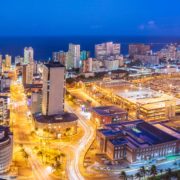This was one of the major findings of the 2018 edition of the African Economic Outlook (AEO) presented to delegates in Addis Ababa, Ethiopia at the recent African Union Summit.
The AEO – African Development Bank’s flagship analysis of the state of African economies – was presented to key stakeholders on the sidelines of the just- concluded 30th Ordinary Session of the Assembly of the Heads of State and Government of the African Union in the Ethiopian capital.
The Bank’s Chief Economist and Vice-President for Economic Governance and Knowledge Management, Célestin Monga, said the report was presented in January to give policy-makers enough time to reflect on the recommendations for economic planning and transformation. Beyond the observed increase in GDP, Monga called for structural change in Africa.
The Bank is also translating the report into key African languages and engaging with policy-makers and civil society organisations to ensure its operationalisation, he said, according to a release issued by AfDB’s Principal Communication Officer, Olivia Ndong Obiang.
Commissioner for Infrastructure and Energy at the African Union Commission, Amani Abou-Zeid, described the report as highly relevant and useful for Governments and other stakeholders.
The African Economic Outlook puts average real Gross Domestic Product (GDP) growth in Africa at 3.6 per cent in 2017 – a good recovery from the 2.2 per cent recorded in 2016. The 2017 figure is projected to grow by 4.1 per cent a year in 2018 and 2019.
Growth was driven by improved global economic conditions, better macro- economic management, recovery in commodity prices (mainly oil and metals), sustained domestic demand (partly met by import substitution), and improvements in agriculture production.
However, the report noted that Africa is still experiencing jobless growth due largely to limited structural change. Consequently, sustained high growth has not had substantial impact on job creation. About two thirds of countries in Africa have experienced growth acceleration.
“Basically, a growth acceleration period is one in which the average growth rate of GDP per capita over a period of eight years is at least 3.5 per cent per annum,” the report notes.
The Commissioner for Economic Affairs at the African Union Commission, Victor Harrison, endorsed the report, urging African countries to adopt the recommendations for inclusive growth.
“These studies present the behaviour of African economies in the face of difficult external conditions and announce the revival of growth with an estimated rate of 4.1 per cent in 2018. We all know that growth is not yet inclusive in Africa, and unemployment affects more women and young people,” he told the audience.
Harrison urged member states to improve the business climate and stimulate the private sector to participate in the development.
According to the Outlook’s findings, Africa’s infrastructure is still behind those of other regions in quantity, affordability, and quality due to lack of investment. At the same level of GDP per capita, South Asia, East Asia and Latin America have higher access to electricity and water than most African countries.
It observed that Africa needs higher growth and investment rates, but debt levels must be monitored closely. Public debt ratios are rated to be on the rise, stocked by appetite for infrastructure spending.
Details provided by the Outlook indicate that 40 countries in the region recorded increases in external debt from 2013-2016. Nine countries experienced a decline.
Though there are growing concerns about the debt levels in Africa, the report indicates that if used productively, debt may be necessary to unlock long-term growth potential.
“Tackling poverty will need efforts to increase employment elasticity of growth. The employment elasticity of growth of 0.41 in Africa is below the desirable 0.7 for all developing countries. Pressing policy concern is therefore to ensure that growth is reflected in creation of high and quality jobs,” according to the Outlook.
The report notes that Africa could be the next investment frontier and recommends three options for the international financial community to resolve the savings glut: the adaptation of a policy of more negative real interest rates in high-income countries; the use of excess savings to finance public investment in rich countries; and the facilitation of the flow of capital to developing countries.
Estimates show that investment needs for infrastructure will be in the range of US $130 – $170 billion a year.
The problem with the infrastructure-deficit approach is the underlying assumption that one day Africa and the world might be able to resolve it. Yet, throughout history, infrastructure deficit has been a perpetual policy problem and solving this remains a work-in-progress, said the Acting Director for Macro- economic Policy, Forecasting and Research Department at the African Development Bank, Abebe Shimeles.
The Bank proposed that many new financing mechanisms could be implemented in all African countries, taking into account the specific economic circumstances and the productive structures of national economies.
The report urged countries to better leverage public funds and infrastructure investments, while encouraging private-sector participation.
“But the different stages of development of African countries mean that the policy approaches need to be country specific. Universal access to high-quality infrastructure is likely to be a long-term goal,” Shimeles said.
Strategic targeting will be essential. Trying to achieve development with limited resources has led governments to spend too much on too many projects with low economic returns and little impetus for industrial growth and employment creation. But African countries do not need to solve all their infrastructure problems before they can achieve sustained and inclusive growth, the report said.
Instead, African countries should focus on how to best use scarce infrastructure budgets to achieve the highest economic and social returns. One pragmatic approach, the report notes, is the creation of industrial parks.
The AEO also called for infrastructure in special economic zones and industrial parks and the mobilisation of domestic resources through well-targeted subsidies and rigorous collection of fees using technology.
It urges Africa to attract more private funding to infrastructure projects, focusing on risk mitigation; to creating an infrastructure asset class to attract institutional investors; choosing appropriate financing instruments to develop infrastructure.
The African Economic Outlook bridges a critical knowledge gap on the diverse socio-economic realities of African economies through regular, rigorous and comparative analysis.
It is produced annually by the African Development Bank and provides short- to medium-term forecasts on the evolution of key macroeconomic indicators for all 54 regional member countries, as well as analysis on the state of socio-economic challenges and progress made in each country.






